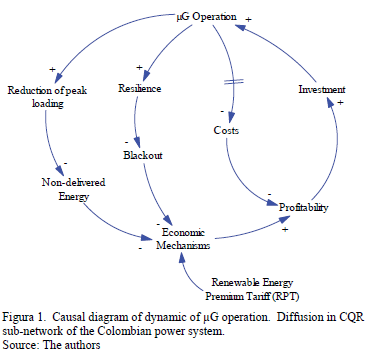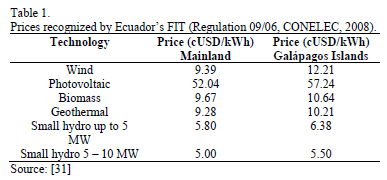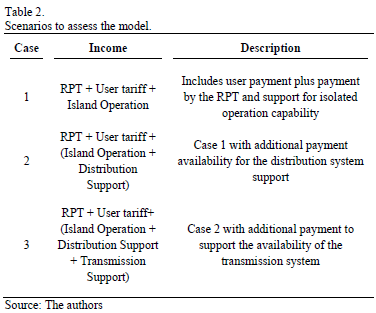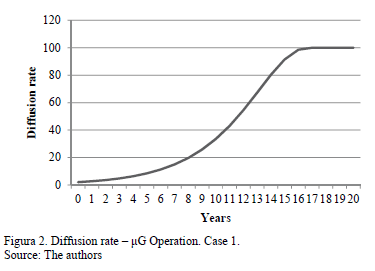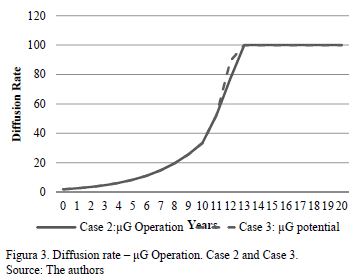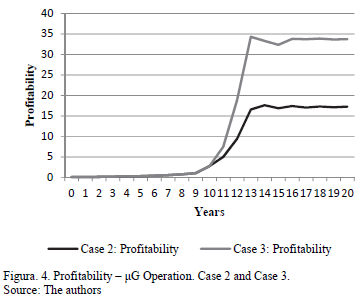Serviços Personalizados
Journal
Artigo
Indicadores
-
 Citado por SciELO
Citado por SciELO -
 Acessos
Acessos
Links relacionados
-
 Citado por Google
Citado por Google -
 Similares em
SciELO
Similares em
SciELO -
 Similares em Google
Similares em Google
Compartilhar
DYNA
versão impressa ISSN 0012-7353
Dyna rev.fac.nac.minas vol.82 no.192 Medellín jul./ago. 2015
https://doi.org/10.15446/dyna.v82n192.48564
DOI: http://dx.doi.org/10.15446/dyna.v82n192.48564
How to promote distributed resource supply in a Colombian microgrid with economic mechanism?: System dynamics approach
Cómo promover el suministro de los recursos distribuidos en una microrred colombiana con mecanismos económicos?: Enfoque con dinámica de sistemas
Adriana Arango-Manrique a, Sandra Ximena Carvajal-Quintero b & Camilo Younes-Velosa c
a Facultad de Ingeniería y Arquitectura, Universidad Nacional de Colombia, Manizales, Colombia. aarangoma@unal.edu.co
b Facultad de Ingeniería y Arquitectura, Universidad Nacional de Colombia, Manizales, Colombia. sxcarvajalq@unal.edu.co
c Facultad de Ingeniería y Arquitectura, Universidad Nacional de Colombia, Manizales, Colombia. cyounesv@unal.edu.co
Received: May, 28th of 2014. Received in revised form: May 5th of 2015. Accepted: .June 17th of 2015
This work is licensed under a Creative Commons Attribution-NonCommercial-NoDerivatives 4.0 International License.

Abstract
Distributed generation currently has caused an increase in the installation or renewable energy generation resources near the consumption centers and the ability to operate in the event of a failure of the interconnected system in isolation mode. However, this type of generation and operation has not progressed significantly in Colombia due to the lack of financial mechanisms. This paper presents a model in System Dynamics that proposes a mechanism for the promotion of distributed resources by including regulatory incentives known as Renewable Energy Premium Tariff and incentives for providing technical support for the distribution and transmission system. Proposed mechanisms help to promote the use of renewable energy in Colombia and further enhance the tools so that grid operators can avoid accidental disconnection.
Keywords: Distributed Resources; Micro Grid Operation; Renewable Premium Tariff; Support Services; Small Hydropower Plants.
Resumen
La generación distribuida actualmente ha provocado un aumento en la instalación de recursos renovables cerca a los centros de consumo con la posibilidad de operar, en caso de una falla en el sistema interconectado, en modo aislado. Sin embargo, este tipo de generación y operación no ha progresado de manera significativa en Colombia debido a la falta de mecanismos financieros. En este trabajo se presenta un modelo en Dinámica de Sistemas que propone la integración de un mecanismo para la promoción de recursos distribuidos como incentivos regulatorios conocidos como Renewable Premium Tariff e incentivos por prestar servicios de soporte al sistema de distribución y de transmisión. Los mecanismos propuestos permiten promover el uso de energías renovables en Colombia y adicionalmente aumentar las herramientas para que los operadores del sistema puedan evitar desconexiones fortuitas.
Palabras clave: Operación por Microrredes; Pequeñas Centrales Hidroeléctricas; Recursos Distribuidos; Renewable Premium Tariff; Servicios de Soporte.
1. Introduction
Microgrids (mG) allow the integration of new power generation technologies in distribution networks, presenting operational advantages such as injection of active and reactive power at different points in the distribution network, by converting distribution networks into active nets [1].
This new mode of operation ensures cleaner energy production at a relatively low cost, and with technical benefits associated with the local reliability, improved quality, security of supply by reduced outages, and reduced emissions by the use of renewable resources [2,3].
According to [4], mG are smart grids of low and/or medium voltage (LV/MV), which include various types of renewable sources such as distributed resources DR and loads connected near the DR. Which operate connected in parallel with the distribution network or when there is some maintenance or emergencies, they have the ability to work autonomously or isolated. However, unplanned operation of the DR in isolated mG presents problems in voltages and frequency of the mG, causing failures in elements connected to it and increasing the mG losses, resulting in reductions of quality rates and reliability, which increases the probability of generating a blackout widespread in the mG and in the distribution system [5].
Correct planning of the mG increases resilience in the operation of the distribution system, preventing current demand disconnections, decreased quality index and security of supply due to random events like atmospheric discharges among others [6,7].
For the integration of the mG in a deregulated system it is necessary to implement economic mechanisms that promote the correct integration of the DR and active demand response programs to provide technical operation and a market dynamic in the mG [8].
This integration should guarantee a sustainable supply of energy for the growing demand at a relatively low cost, taking into account the location, technologies used and dimensions of the DR [2]. Additionally, the costs incurred in the integration of the DR and the operation of the mG should be considered, as investment costs or Capital Expenditures (CAPEX) and operation and maintenance costs or Operational Expenditures (OPEX) to determine the actual economic benefit, by conducting an analysis of the income of the operation by mG [9,10].
The aim of this paper is to determine through economic mechanisms the promotion of mG operation under the conditions of distribution network in the Caldas, Quindío and Risaralda (CQR) areas, considering DR and a reduction in peak demand. There are mechanisms that facilitate the adaptation of the DR and demand in market dynamics, reducing long-term costs, user's tariff and the losses in the transmission and distribution systems which imply long-term postponement of investments in infrastructure [11,12].
It is important to consider that the technical operation and economic and market behavior depend on the dynamics of the mG itself and the optimal integration of the DR and the demand response programs [6,8]. However, one must consider that each mG has specific characteristics depending on the geographic location, the primary source of generation, implemented technologies and behavior of the demand [4].
It is proposed to analyze the possibility of implementing a mG in the CQR area of the Colombian electric power system (EPS), which is characterized by the use of Small Hydroelectric Plants (SHPs) owing to the large quantity and great hydro potential of rivers with high waterfalls in this area, a product of the Andes Mountains which cover this region [13], using a simulation model in System Dynamics (SD) to analyze long-term contribution of support services and economic mechanisms such as the Renewable Energy Premium Tariff (RPT) to determine the behavior and growth of the operation by mG. The most important contribution of this research is the analysis of investment in mG, combining the benefits inherent in the implementation of the mG to the distribution network and the transmission, and implementing economic mechanisms that facilitate the participation of DR and demand response program in providing reliability and security of supply.
This paper is structured as follows: in Section II a model of the diffusion of mG in SD and an analysis of different features for its implementation are presented, taking into account the income and costs incurred in this type of operation. In Section III the results are presented of the simulations carried out using the diffusion model in different scenarios. Finally, the conclusions are described in Section IV.
2. System Dynamics
System Dynamics (SD) is the methodology used to analyze the dynamic behavior of economic mechanisms in the diffusion mG model [14]. SD is based on a group of elements constantly interacting with one another with the aim of finding the structural causes that bring about the behavior of the system being analyzed [15]. The models are composed of differential equations that are resolved using numerical integrations [16]. The standard system dynamics approach to modeling starts by establishing the feedback and delays in the system to be investigated, followed by a stock and flow diagram, and finally the formal equations, which are differential equations. This formalization allows the system to be simulated. For a detailed description and discussion of system dynamics modeling, formalization, and verification see Sterman [14].
The model is characterized by the conditions of the CQR area, and is used for the planning of the mG type with SHPs. The proposed planning model can be used for decision-making, taking into account not only the criterion of the lowest cost, but also including new evaluation criteria such as profitability [17] and technical support for the safe operation of the mG.
2.1. Causal diagram
The causal diagram or feedback diagram shown in Fig. 1 shows the causal relationships between the main variables of the system and the relationships that allow us to study the dynamics of the mG.
The causal diagram consists of three positive cycles, which are associated with the benefits accompanying the operation by the mG system. First, the contribution to the distribution system is associated with the reduction of peak demand on the EPS seen from centralized generators by reducing demand fluctuations, because the DR provides energy directly to the consumer centers, ensuring a constant supply to users who are connected to the mGoperating in isolation, and decreasing the levels of non-delivered energy and reducing blackouts that may occur. Therefore, this condition has economic rewards [18].
Likewise, the operation by mGincreases resilience in the operation of electric power systems, associated with the ability to expand by taking into account alternative and renewable generation, adaptation to different geographical locations, control strategies for centralized coordination between the substations and control centers, support for multiple markets, and connection or disconnection of DR and loads [19].
The reduction in costs has a delay, shown in Fig.1 by "=", because methodologies are used to quantify the behavior patterns of the cost in time by one of the most common techniques, known as learning curves.
The diagram in Fig. 1 shows how the operation of an isolated mGenhance the level of investment in the operation by mG, increasing the capacity of an isolated operation of mGin supporting both the distribution and the transmission system
2.2. Formulation of the simulation model
The causal diagram shown in Fig. 1 translates to a formal diagram which provides a detailed analysis of the variables of the model in specialized software [16]. The model is composed of level variable, which accumulate system information and present relationship changes due to the relation flow rates, which determines changes in the system and allows dynamic behavior to occur [20,21].
The simulation model consists of the level variables associated with increases in the operation by mG; these variables are associated with the growth rate of the mGrelated to the level of investment or profitability.
2.2.1. Distribution system benefits
The growth in demand leads to file system failures, power outages and rising electricity prices [18]. Also, the prediction of behavior of the demand presents difficulties and complexities to determine it and limits the data for implementing the methodologies, which hinders the making of operational decisions and strategies regarding behavior and growth [22]. However, the presence of DR in the mG operation can reduce peak demand (seen from the distribution system), extending the useful life of distribution assets. In general, DR is dispatch continuously, i.e., is not intermittently, which ensures that the reduction occurs at peak demand [18].
This reduction in peak demand directly influences security of supply by improving the reliability of mGby the contribution of the DR installed close to the demand; in this case, mGcan reduce the indices of duration and frequency of the interruptions experienced by users connected to the mG[18]. These indices are SAIFI and SAIDI and are represented in (1) and (2), respectively.

Where Niis the number of users affected by each interruption, determined by making an annual analysis of them using the data of the system operator [23], NT is the total number of users connected to the mG,and ri is the duration of interruptions submitted annually.
Equation (3) expresses the energy that is not delivered due to the reliability indices (adapted from [18]).

In the case of an isolated mG, sufficient dispatchable generation should be ensured to accommodate variations in demand [18]. However, for the model a reduction in peak demand is assumed, so that the reliability indices SAIFI and SAIDI are improved and ensure security of supply to the mG[19]. In Colombia, if the percentage of non-delivered energy exceeds 2%, a detailed analysis must be performed of the situation that caused the partial or total unavailability and what occurred in a scheduled or unscheduled manner [24].
2.2.2. Transmission system benefits
The existing EPS were designed for centralized generation, which is increasingly challenged by the negative effect it causes in the environment. In addition, centralized generation does not, in case of a failure, continue to operate in subsections or operational areas in order to avoid disconnection of the end user. Smart grids allow operation in an intentional island mode or operational area through the creation of a mG [1,4].
The operating philosophy from this point of view is based on a process of restoration where the main objective is to achieve total EPS interconnection in the shortest time possible. With the inclusion of smart grids the key concept should be to prevent the end user from experiencing an interrupted supply of electricity. The term that relates to non-interruption of electricity in case of a failure in EPS is self-healing and is related to the possibility that restoration process may be performed using multiple distribution networks with active acquisition systems. Real-time data can be synchronized and thus ensure security of supply to the end user [25].
In the future, a fast self-healing capability will enable the electric power system to operate as multiple islands intentional at any voltage level and thus avoid costly blackouts. The customer plays a key role in creating stable electrical islands because success in creating electrical islands is based on the proper management and control of loads.
Such controllable loads must be connected in active distribution networks, which should make changes to the mode of operation such as the inclusion of DR that causes bidirectional flows, which must be measured and controlled in real time by checking constraints.
Such constraints relate to the need to maintain the frequency and voltage within allowable values in the operating of multi mG which may form in the distribution system, and which will assist in strategy through strategic modules created by the operator of the national power system, who will be able to start large generation plants and restore the interconnection and unity of the overall power system (bulk power system).
2.2.3. Economic Mechanisms
The decision criterion on which mR is implemented depends on regulatory conditions prevailing in Colombia concerning the issue of mG. Currently, distributing agents in Colombia can have generation assets [26]; for this reason, if the regulatory conditions do not change, the implementation of mG is governed by a monopoly model of distributing agents.
In a monopoly model, the mR is built primarily to address problems of electrical power quality or to postpone expansions in the distribution network given the compensation of reactive power that can deliver the mG [27]. Therefore, in a monopoly model the technical conditions are a bonus because the current regulations do not allow them to have a unique local market for mGthat could compete with the wholesale market [26].
Also in the monopoly model, the active integration of demand is not a priority because the broker-dealer would have to implement differential rates, and income could be reduced if the customer could choose between buying local energy or mG from the wholesale energy market [28].
The diagram shows that the integration and operation of the mG increases the level of investment in this technology, as it increases the ability of the DR and the active participation of demand to ensure the reduction in peak consumption. This investment will reduce costs over a period of time, as mentioned above, by learning curves.
To encourage renewable energy penetration in developing countries it is necessary to implement a scheme that is financially and technically sustainable in the long term and which requires minimal intervention from governments or regulations [11,29].
Traditional schemes have been "tropicalized" to analyze the behavior and possible integration in developing countries. For this we have proposed the implementation of a sustainable scheme called: Renewable Energy Premium Tariff (RPT) [11,29-32].
This scheme includes demand as a major player in the energy market and especially for the financial support and to ensure the sustainability of the scheme of the growth of the DR, representing a change in the price elasticity before the acceptance of this change in technologies [11]. This mechanism is developed around the Feed-in-Tariff (FIT) with local adaptations that depend on technological, socioeconomic development and on the operation of isolated mG [32].
The implementation of RPT is not intended to finance capital investments in renewable energy projects, as would be the case of FIT. The aim is to ensure high levels of performance because the payments are based on power generated. The RPT was designed to provide a cost-benefit mechanism, designed to introduce renewable energy technologies in isolated mG and provide sustainable, affordable electricity to the users connected to it [31]. In [32] the equation for income as shown in (3) is defined.

However, the proposal of this work and other sustainable options is to consider the support services that operation by mG can provide to the distribution and transmission system. The equation that describes the behavior of the proposed economic mechanisms which benefit from the operation by mG is defined in (4).

Where User tariff is the rate that the user pays for the service of electricity, the rate for the Colombian case can be compared to the price paid by users in Non-Interconnected Areas (ZNI), defined by Resolution CREG 091 of 2007 [33], defined in (5).

Where Gm is the maximum available capacity charge, p is the losses in the system, Dmn is the charge for use of the distribution system and Cm is the marketing fee. These data are defined in [33]. Support services are the benefits that lend mG for both the distribution system and the transmission system, the latter being an incentive for both mG and for the EPS and the price RPT is recognized by the government and uses the example of the prices recognized by FIT Ecuador for different technologies shown in Table 1 [31].
2.2.4. Costs
Learning curves describe how investment costs in a technology are reduced through one or more factors that represent the accumulation of knowledge and experience related to Research and Development (R & D), production and use of such technology [34,35]. The cost of DR is reduced, as mentioned above, due to new technologies, programs of asset management and scheduled maintenance, also investment would be conditioned by the profitability of the plant and the ratio of income to support costs of the operation of the mG.
The costs that are included in the simulation model are defined as CAPEX, known as investment costs associated with installing plants, taking into account the rate defined by the CREG using a calculation method known as the Weighted Average Cost of Capital (WACC). This method aims to remunerate shareholders' investments in the same way that a company functioning efficiently in a sector characterized by comparable risk would be remunerated [23], as is shown in (6). CAPEX have a similar behavior pattern to that of a learning curve, meaning that CAPEX are reduced over time owing to the fact that it becomes increasingly easier to implement DR due to new experience gained on each project.

The learning rate of SHPs in the world is very low (1.4%), mainly because it is considered a technology that has not changed in the last 50 years [36]. However, this theory must be staked to the topic of smart grids and the possibility of functioning in an interconnected network and a grid with acceptable levels of quality, reliability and security of supply.
2.2.5. Profitability
In this research we propose mG operation for a distribution sub-network in Colombia - CQR zone; the final decision of the alternative selected operation must consider: reliability, quality indices, benefit/cost, among others. Regardless of the selection, the operation of the studied mG shows good technical performance and system variables remain within acceptable ranges of operation; thus it appears that this type of operation is feasible.
The analysis of profitability in the implementation model of economic mechanisms, as mentioned in section 3), determines the level of investment for expansion of the mG operation. The profitability depends on the relationship between income and the economic mechanisms, considering RPT rates and benefits for system support, to ensure sustainability in the operation by mG and costs incurred through investment, operation and maintenance of the operation by mG, discussed in Section 4). Equation (7) determines the profitability of the investment.
Where income that is associated with equation (4) and the CAPEX defined in equation (6) and OPEX are defined in [23].

3. Simulations and results
The model was constructed to analyze the economic mechanisms to promote DR in the operation of such a mG island in Colombia. It implements the RPT and additionally proposes the integration of availability payment for the provision of services of support of the EPS.
The model evaluation is defined by the following stages, as shown in Table 2.
To analyze the diffusion rate of the operation by mG in the CQR area, which has DR as the SHPs, we must assess growth in the mG operation in the area. The value that is allocated for support services is equal to the value of the single supplementary service available in Colombia, the AGC service, since it is considered that the isolated mG operation helps in providing these support services, enabling the distribution system to be active and to support the needs of transmission systems and large centralized generators.
3.1. Case 1:
In Case 1, the simulation is performed taking into account the fee paid by users, defined from CREG Resolution 091 of 2007 [33], the RPT taken from Table I for the SHPs [31] and payment for service support for island operation capability.
Fig. 2 shows that in 20 years the rate of diffusion only reaches 100% in the 16th year, takinginto account what is paid to the mG a payment for availability of island operation. For the 10th year profitability, under a cost-benefit ratio analysis, is greater than 1, having implications for investors due to the coverage of costs incurred and a return on investment that favors the spread of the mG operation and ensures long-term sustainability.
3.2. Case 2 and case 3:
In case 2, it is proposed to implement, in addition to the rates of the users [33], the RPT [31] and an availability payment for the provision of support to the distribution network, defined in section II B. 1, and an additional payment for island operation.
In the last case, case 3, it is proposed to implement, in addition to the rates of the users [33] and the RPT [31], a payment for additional availability to provide support services to the transmission network, as expressed in section II B. 2, also maintaining the availability payment for the distribution system and the ability of isolated operation.
Diffusion behavior shown in Fig. 3 presents an improvement over Case 1 because, in the 20 years analyzed in this model, the diffusion reaches 100% in the 13th year, which implies a favorable investment. Payment for support service being provided to the system increases from year 11, because it starts to compensate when 33% of the DR projected is operating in mG, so that at the beginning of the operation the behavior of the diffusion is similar to Case 1.
Adding the payment for availability to support the transmission system and, conjugated with the support to the distribution network, the rate of diffusion of the operation by mG in the Colombian system is feasible.
However, technical studies should be conducted to avoid saturation of the system and ensure that the DR system is integrated to provide the support services properly and adequately. Additionally, demand should be considered as an active agent that participates in the market and that has great advantages for the operation of EPS.
3.3. Profitability
Case 2 and Case 3 have similar behavior; however, the profitability of the two cases is shown in Fig. 4 and shows what occurs when applying the two types of incentives.
Fig. 4 shows that the profitability increases significantly from the moment you start paying support services for the distribution and transmission network, making this type of operation competitive and ensuring a return on investment. These mechanisms are intended to be sustainable in the long term because the payment is to help the EPS to stay within operating limits, increasing the security of supply and maintaining the reliability and quality indices. However, technical analysis should be performed to ensure the above conditions.
4. Conclusions
This article proposes using the mG as a form of operation that brings benefits to the EPS, with the ability to provide support services through an economic evaluation using mechanisms that allow penetration and growth of the operation by mG, including the RPT which is known worldwide, and an availability payment to provide support services for the distribution and transmission system.
Implementation of economic mechanisms such as RPT has benefits for the investor, taking into account that it ensures the long-term cash flow, decreasing the investment risk. However, one must consider the conditions of the region, such as its geographical and climatic characteristics, as the payment to cover the costs for RPT is a guarantee for the investor and reduces investment risk.
The successful implementation of support services proposed in the paper is based on a strong policy that covers all the specific characteristics of the mG and a regulatory framework, to eliminate the barriers associated with the implementation of the mG, DR and renewable energy.
To provide ancillary or support services using mG is a regulatory challenge for Colombia since it would have to modify procedural aspects and invest in modern equipment measurement and control. Furthermore, the issue should be regulated to remunerate the demand participation to convert it into a stable demand in the long term, as this would allow deferrals in the investment of expansion of the generation and networks of transmission and distribution of the EPS. The active participation of demand allows better use of generation resources through voluntary shedding of the demand. Furthermore, demand in a mG with measurement and control equipment with telemetry can provide specific support services as tertiary control frequency and voltage control; in this way, it would increase the reliability and optimize the utilization of the resources of the mG.
The operation by mG in Colombia does not have a regulatory policy that encourages this operation, so investors will continue to build SHPs with conventional control systems that do not allow island mode operation and therefore, are missing the opportunity to have a resilience EPS and higher rates of security of the supply of electricity.
For the Colombian EPS to increase resilience, stability and security of supply, it is necessary to promote, implement and regulate the operation form of mG and thus modernize the operation of the EPS and achieve multiple benefits (technical, economic, environmental and social) for all those involved in the electric supply chain.
References
[1] Sioshansi, F.P., Smart Grid: Integrating renewable, distributed & efficient energy. Waltham: Academic Press, 2011. [ Links ]
[2] Mejia-Giraldo, D.A., Lopez-Lezama, J.M. and Gallego-Pareja, L.A., Energy generation expansion planning model considering emissions constraints, DYNA, Universidad Nacional de Colombia, 77 (163), pp. 75-84, 2010. [ Links ]
[3] Sanseverino, E.R., Di Silvestre, M.L., Ippolito, M.G., De Paola, A. and Lo Re, G., An execution, monitoring and replanning approach for optimal energy management in microgrids, Energy, 36 (5), pp. 3429-3436, 2011. DOI: 10.1016/j.energy.2011.03.047 [ Links ]
[4] IEEE, Guide for design, operation and integration of distributed resource island systems with electric power systems, IEEE Standard 1547.4TM, Jul. 2011. [ Links ]
[5] Soto, D., Edrington, C., Balathandayuthapani, S. and Ryster, S., Voltage balancing of islanded microgrids using a time-domain technique, Electric Power Systems Research, 84 (1), pp. 214-223, 2012. DOI: 10.1016/j.epsr.2011.11.022 [ Links ]
[6] Peças-Lopes, J.A., Hatziargyriou, N., Mutale, J., Djapic, P. and Jenkins, N., Integrating distributed generation into electric power systems: A review of drivers, challenges and opportunities, Electric Power Systems Research, 77 (9), pp. 1189-1203, 2007. DOI: 10.1016/j.epsr.2006.08.016 [ Links ]
[7] Lorente-de la Rubia, J., Estudio sobre el estado actual de las "Smart Grids, Tesis, Departamento de Ingeniería Eléctrica, Universidad Carlos III de Madrid, Madrid, España, 2012. [ Links ]
[8] Muñoz-Maldonado, Y.A., Optimización de recursos energéticos en zonas aisladas mediante estrategias de suministro y consumo. PhD Tesis, Departamento de Ingeniería Eléctrica, Universidad Politécnica de Valencia, España, 2012. [ Links ]
[9] Frías, P., Gómez, T. and Rivier, J., Regulation of distribution system operators with high penetration of distributed generation, Proceding of Power Tech, 2007 IEEE Lausanne, pp.579-584, 2007. [ Links ]
[10] Sánchez-de Tembleque, L.J., Sostenibilidad de las energías renovables, Fundación Ciudadanía y Valores, 2009. [ Links ]
[11] Thiam, D.R., An energy pricing scheme for the diffusion of decentralized renewable technology investment in developing countries, Energy Policy, 39 (7), pp. 4284-4297, 2011. DOI: 10.1016/j.enpol.2011.04.046 [ Links ]
[12] Barker P.P. and de Mello, R.W., Determining the impact of distributed 5 generation on power systems: part 1 - radial distributed systems, IEEE Power Engineering Society Summer Meeting, 3, pp.1645-1656, 2000. [ Links ]
[13] Díaz, A., Identificación y evaluación de un conjunto de medidas e incentivar la penetración de energía renovable en la generación de electricidad de Colombia, MSc, Tesis, Departamento de Ingeniería Eléctrica, Universidad de los Andes, Bogotá, Colombia, 2007. [ Links ]
[14] Sterman, J., Business dynamics. Systems thinking and modeling for a complex word. McGraw-Hill, 2000. [ Links ]
[15] Dyner, I., Dinámica de sistemas y simulación continua en el proceso de planificación, 1993. [ Links ]
[16] Borshcev, A. and Filippov, A., From system dynamics and discrete event to practical agent based modeling: reasons, techniques, tools., Proceeding of the 22nd International Conference of the System Dynamics Society, Oxford, England, 2004. [ Links ]
[17] Lemos-Cano, S. and Botero-Botero, S., Hydro-Thermal generation portfolio optimization at the colombian power market, DYNA, Universidad Nacional de Colombia, 79 (175), pp. 62-71, 2012. [ Links ]
[18] Morris, G.Y., Abbey, C., Wong, S. and Joos, G., Evaluation of the costs and benefits of microgrids with consideration of services beyond energy supply, Proceeding of Power and Energy Society General Meeting, 2012 IEEE, pp.1-9, 2012. DOI: 10.1109/pesgm.2012.6345380 [ Links ]
[19] Li, F., Qiao, W., Sun, H., Wan, H., Wang J., Xia, Y., Xu, Z. and Zhang, P., Smart transmission grid: Vision and framework, smart grid, IEEE Transactions 1 (2), pp.168-177, 2010. [ Links ]
[20] Kundur, P., Paserba, J., Ajjarapu, V., Anderson, G., Bose, A., Cañizares, C., Hatziargyriou, N., Hill, D., Stankovic, A., Taylor, C.W., Van Custem T. and Vittal, V., Definitions and classification of power system stability, IEEE/CIGRE joint task force on stability terms and definitions, IEEE Transactions on Power Systems, 19 (3), pp. 1387-1401, 2004. DOI: 10.1109/TPWRS.2004.825981 [ Links ]
[21] Forrester, J., Principles of systems. Norwalk, CT: Productivity Press. 1961. [ Links ]
[22] Rueda, V., Velásquez-Henao, J.D. and Franco-Cardona, C.J., Recent advances in load forecasting using nonlinear models, DYNA, Universidad Nacional de Colombia, 78 (167), pp. 36-43, 2011. [ Links ]
[23] Central Hidroeléctrica de Caldas - CHEC S.A. ESP., Estudios de viabilidad de las plantas menores para las pequeñas centrales hidroeléctricas de propiedad de la CHEC. Contrato NO.177.08. 3er Informe de actividades, Septiembre, 2009. [ Links ]
[24] CREG, Comisión de Regulación de Energía y Gas, Resolución 93, 2012., Reglamento para el reporte de eventos y el procedimiento para el cálculo de energía no suministrada, y se precisan otras disposiciones relacionadas con la calidad del servicio en el sistema de transmisión regional., [Online]. Available at: www.creg.gov.co/eléctrica/info.html [ Links ]
[25] Madureira, A.G. and Peças-Lopes, J.A., Ancillary services market framework for voltage control in distribution networks with microgrids, Electric Power Systems Research, 86, pp. 1-7, 2012. DOI: 10.1016/j.epsr.2011.12.016 [ Links ]
[26] CREG, Comisión de Regulación de Energía y Gas, Resolución 25, 1995. Código de Redes. [Online]. Available at: www.creg.gov.co/eléctrica/info.html. [ Links ]
[27] Hatziargyriou, N.D., Anastasiadis, A.G., Vasiljevska, J. and Tsikalakis, A.G., Quantification of economic, environmental and operational benefits of Microgrids, Proceeding of Power Tech, IEEE Bucharest, pp.1,8, 2009. [ Links ]
[28] More Microgrids, STREP project funded by the EC under 6FP, SES6-019864, Advanced Architectures and Control Concepts for More Microgrids, Report on the technical, social, economic, and environmental benefits provided by Microgrids on power system operation, 2009. [ Links ]
[29] Rickerson, W., Hanley, C., Laurent, C. and Greacen, C., Implementing a global fund for feed-in tariffs in developing countries: A case study of Tanzania, Renewable Energy, 49, pp. 29-32, 2013. DOI: 10.1016/j.renene.2012.01.072 [ Links ]
[30] Moner-Girona, M., A new tailored scheme for the support of renewable energies in developing countries, Energy Policy, 37 (5), pp. 2037-2041, 2009. DOI: 10.1016/j.enpol.2008.11.024 [ Links ]
[31] Solano-Peralta, M., Moner-Girona, M., Van Sark, W.G.J.H.M. and Vallvè, X.R., Tropicalisation of Feed-in Tariffs: A custom-made support scheme for hybrid PV/diesel systems in isolated regions, Renewable and Sustainable Energy Reviews, 13 (9), pp. 2279-2294, 2009. DOI: 10.1016/j.rser.2009.06.022 [ Links ]
[32] Moner-Girona, M., A new scheme for the promotion of renewable energies in developing countries, JRC European Commission, 2008. [ Links ]
[33] CREG, Comisión de Regulación de Energía y Gas, Resolucion 91, 2007. Metodologías generales para remunerar las actividades de generación, distribución y comercialización de energía eléctrica, y las fórmulas tarifarias generales para establecer el costo unitario de prestación del servicio público de energía eléctrica en zonas no interconectadas. [Online]. Available at: www.creg.gov.co/eléctrica/info.html. [ Links ]
[34] Taillant, P., L'analyse évolutionniste des innovations technologiques: l'exemple des énergies solaire photovoltaïque et éolienne. PhD. Tesis, Université de Montpellier I, France, 2005. [ Links ]
[35] Papineau, M., An economic perspective on experience curves and dynamic economies in renewable energy technologies. Energy Policy 34, pp. 422-432, 2006. DOI: 10.1016/j.enpol.2004.06.008 [ Links ]
[36] Jamasb, T., Technical change theory and learning curves: Patterns of progress in energy technologies, The Energy Journal, 28 (3), pp. 45-65, 2007. DOI: 10.5547/ISSN0195-6574-EJ-Vol28-No3-4 [ Links ]
A. Arango-Manrique, is MSc in Industrial Automation, Electric Engineer, member of Research Group on E3P at Universidad Nacional de Colombia, Manizales Campus. Is student of Doctorate in Engineering, Universidad Nacional de Colombia, Manizales Campus.
S. X. Carvajal-Quintero, is PhD. In Electrical Engineer, member of Research Group on E3P at Universidad Nacional de Colombia. Full professor, at Universidad Nacional de Colombia, Manizales Campus. Field of interest: Smart grids, Ancillary services, System Dynamics and Electricity Markets.
C. Younes-Velosa, is PhD. Electrical Engineer, Manizales Campus. Associate Professor with the Department of Electrical and Electronic Engineer, Manizales Campus.













